Twelve Sons, Twelve Constellations
by John P. Pratt
Reprinted from Meridian Magazine (13 Jul 2005).
©2005 by John P. Pratt. All rights Reserved.
Index,
Home
Relating the twelve tribes of Israel to the twelve zodiac constellations helps
unravel the mystery of the Lord's sacred calendars.
There is a strong Hebrew tradition that each of the twelve tribes of Israel was associated with one
of the twelve constellations of the zodiac. The precise identification of which constellation goes
with which of Jacob's sons has only been known with certainty for four of the tribes. Each of the
twelve carried a banner or flag, and the many of those flags are believed to have displayed one of the zodiac symbols. Thus,
those figures came to symbolize the entire tribe to a large degree, much as the eagle represents the
United States. This article proposes a correspondence of each of those tribes to one of the zodiac
emblems, based on proposed dates for the birth of each. Knowing those dates then leads to greater
understanding of the holy days on the Hebrew Calendar, and testifies of the Lord's foreknowledge
of all things and of his great plan of salvation.
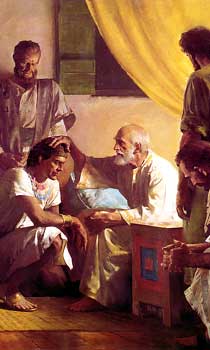 |
Jacob alludes to the zodiac as he blesses his twelve sons.
What does the zodiac have to do with the twelve tribes of Israel? Aren't the zodiac signs the basis
of astrology, and isn't that a false belief system? Wasn't Israel admonished over and over not to
worship the hosts of heaven? Why would Israel put zodiac figures on their flags?
It is not surprising if these are your first questions as you read this article, especially if this is the
first you've read on the subject. As has been pointed out in numerous earlier articles,[1] the Book
of Enoch records that an angel revealed the constellation figures to the prophet Enoch some 5,000
years ago, and many scholars claim they symbolize the key features of the gospel of Jesus Christ.
Last month's article proposed that each of the twelve constellations of the zodiac, through which
the sun appears to travel during the year, represents one of the twelve principal roles of the
Savior.[2]
Satan twists truth and perverts it for his own purposes, which he has clearly done with the zodiac
signs. That causes many to avoid the entire subject, but the symbolism of these figures is so rich
that it would be a tragedy not to learn of the beauty of their meaning, and the clarity of their
symbolism. So my articles on the subject attempt to ignore the perversions and focus on the good.
My position is that the sun, moon, and planets are like the hands on a huge clock, with the twelve
zodiac constellations through which they move being the 12 numbers on the clock face. The Lord uses his clock to time key events in world history. But when Israel began to worship the hands on the clock, as did the pagan nations, then they were told they had missed the whole point, and to desist. Similarly today, if someone believes the planets are controlling his life, rather than merely keeping time, then Satan could falsely convince him that he is not responsible for his actions.
Having that disclaimer in mind, let us look at the evidence, even from the Bible itself, that the
twelve sons of the prophet Jacob were each identified with a different sign of the zodiac.
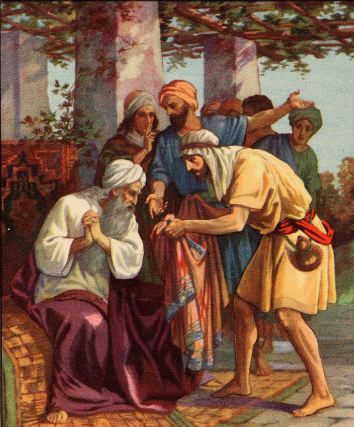 |
Naphtali shows Joseph's blood-stained coat to Jacob.
First, consider the dream of Jacob's son Joseph, of the sun, moon and 11 stars (11
constellations?). He dreamed that they all bowed down to him (Gen. 37:9). When he told the
dream to his family, they immediately knew that the 11 stars referred to his 11 brothers. Was that
just because of the number eleven, or what it also because they already knew that each was
associated with a different zodiac constellation? Evidence for answering this question affirmatively
comes from noting that most of their names have close ties to the zodiac constellations, as discussed below.
Secondly, when the tribes received blessings under the hands of their father Jacob and
many years later by Moses, many unmistakable references were made to zodiac constellations.
Moreover, visions such as those of Ezekiel and John, describe figures with the heads of a man,
lion, ox, and eagle, which just happen to match the four "cornerstone" constellations (Ezek. 1:10,
Rev. 4:7).[3] It is precisely these four key figures which are the most easily matched with the four principal sons of Israel because each is mentioned in the blessings. Reuben is compared to a man and to water, Judah is compared to a lion, Dan to a serpent (counterpart of the eagle), and Joseph's two sons to the horns of the wild ox. Those link to the constellations of the Water Bearer, the Lion, the Scorpion, and the Bull, respectively (Gen. 49: 4, 9, 17; Deut. 33:17). Those four sons are each also assigned to four directions
(Num. 2:3, 10, 18, 25), and those four constellations are evenly spaced around the circle, as are the four
points of a compass. And even non-Israelite prophets, such as Balaam, have used the same figures to
represent the tribes (Num. 24:7-9). All of this has been discussed in detail in earlier articles, and is
summarized here only as review and to make it clear that the Lord himself uses the symbolism.
There is something very profound going on here, and it is certainly seems worth investigating.
Until now, the identification of the constellations associated with the other eight tribes has not been known with any degree of confidence. The other references to the zodiac are sketchy,
and different scholars have proposed a variety of associations based on scriptural clues. But
historical evidence of exactly what emblems were shown on which flags has been weak, and is
based mostly on tradition. Thus, the information about the zodiac associations has been lost. This
article proposes a correlation based on the "brute force" method of actually determining the birth
dates of the twelve sons, and then looking at which constellation the sun was in at their birth.
1. Determining Birth Dates
As is known to readers of my earlier papers, I have discovered a variety of sacred calendars, which
the Lord seems to be using, including the Venus, Mercury, Enoch, and (Perpetual) Hebrew calendars.[4]
My articles have proposed a framework of key religious dates in the history of mankind, from
Adam down to the present day. Let us now begin to fill in more dates into that framework, and
even be bold enough to propose precise dates for all of the twelve sons of Israel, and for two of their
mothers, Leah and Rachel.
1.1 Seven Children in Seven Years
How is it possible to propose precise birth dates when the birth year is not given in the Bible for
even one of the sons? In my former articles, at least the year was provided. Dates were proposed
based on the birth dates being holy days on sacred calendars (especially the Hebrew calendar).
How should we proceed if the years at not even provided? The answer is that it is clearly a puzzle
to be solved, and the years are not necessary. The big clue is that we can calculate the seven-year
period in which eleven of the twelve sons were born, and also the one daughter Dinah. If those
dates must also fall on holy days on the Hebrew calendar and simultaneously on holy days of the
Mayan Sacred Round,[5] then there are only a few dates available. If it turns out that there are
twelve dates in the seven years specified, and it also happens that all twelve occur in different signs
of the zodiac, then we have the beginning of evidence that we are correct. If the
four principal tribes fit the cornerstone constellations and that the names and blessings of other
tribes fit their respective figures, then the evidence becomes more compelling that we have solved
the puzzle. So with that hope in mind, let us proceed.
The curious thing about the history of the birth of Leah's six sons and one daughter in a seven year
period is that she had a barren period during that time. She was so distressed that she had stopped
bearing children that she gave her handmaid Zilpah to her husband to bear children for her. Now
when is the last time you saw something like that on the evening news? How many mothers do
you know who had four children in four years who then became distraught when they didn't have
a fifth in the next year? Both of Jacob's wives clearly qualify as understanding the importance of
the blessings of having a large posterity. So we begin to see that the pieces of this puzzle must be
very tight-fitting indeed because 7 births can barely be squeezed into those time constraints. So if it
turns out that they drop into place perfectly, then it will be amazing indeed. Of every 18,600
families which have exactly twelve children, on the average only one will have each born in a
different month of the year or with the sun in a different constellation. If the precise time of birth is known, then there is only about one chance in forty that any one date is holy on both of those calendars. Accordingly, if blind chance governed the universe, then there would be negligible probability that even one family in history could have such a noble set of birth dates. It has occurred to me that it would be interesting to calculate just how many seven-year periods even contain twelve such dates.
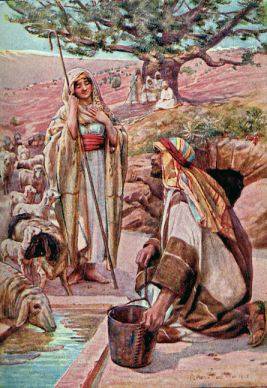 |
Jacob and Rachel meet (Gen. 29).
Let us review the entire story briefly in order to find the seven-year period. Jacob worked seven years to marry his beloved Rachel, and
awoke after the wedding to find he had married her older sister Leah. How could that happen? The
Book of Jasher, which is an excellent chronological source,[6] states that they were twins. It was
still very important that one was slightly older than the other. Moreover, the
bride's face was most likely veiled. In any case, seven days later he married Rachel. Leah gave birth to
four children in succession: Reuben, Simeon, Levi, and Judah. Rachel was barren, which was
considered a great curse, because it would mean no posterity, no family. When it was clear she
was not bearing, she gave her handmaid Bilhah to her husband, and Bilhah bore Dan
and then Naphtali. Note that we are not told that Dan is born after Judah, although that is usually
assumed. Then it was Leah's turn to have a barren period. Each of her four children were
probably born about a year apart. It must have been at least six months after the birth of Judah that
she realized that she was not expecting and got nervous because by then Bilhah's second son was
probably born. So Leah gave her handmaid Zilpah to Jacob to even up the odds. Zilpah bore Gad
and Asher. Again we are only told the order of birth to each mother.
Now the plot thickens. We find that part of the reason for Leah's barren period was that Jacob was not
spending his nights with her. When Leah's son found some fertility herbs, Rachel traded her sister
Leah a night with Jacob in exchange for them. Sure enough, the trade was a success for
Leah, who soon gave birth to Issachar, and later to Zebulon and Dinah. Then, finally, Rachel gave birth to Joseph. His birth was the last because immediately afterward Jacob told Laban that the second set of seven years had past, and that he wanted to take his family back to his own country (Gen. 30:25).
So these four women had twelve children (11 sons and a daughter) in seven years. And Leah alone
had seven of them, with a barren period. Allowing a least an extra year for the barren period,
wouldn't that have taken Leah eight years to have seven children? When I began calculating the
dates, it became clear that the only solution was that Zebulon and Dinah had to be twins. After I
discovered that, I found it confirmed in two sources. First it is Hebrew tradition that they were
twins.[7] Secondly, it states it implicitly in the Bible itself. For all of the other children, we are told
that "Leah conceived" and brought forth a son. When it gets to Dinah it doesn't state that she
conceived again, but only that she brought forth Dinah after Zebulon (Gen. 30:21). In other words,
it implied that they are twins by leaving out the word "conceived." It is accuracy in minute details
such as this which has led me to believe that Genesis is a revelation from God, rather than an
attempt by Moses to record oral traditions. So that eases the requirement somewhat, for now we
need only six birth dates in seven years, with an extra year between the fourth and fifth dates.
1.2 Which Seven Years?
Just when is the seven-year period during which Jacob's first twelve children were born? The
scriptures provide us enough detail to zero in on the exact seven year period. Let us begin by
reviewing the chronological framework already established in earlier articles.
Jacob, later renamed Israel, was the father of the twelve sons who became the heads of the twelve
tribes of Israel. As was proposed in an earlier article, Jacob was born on Wed 20 Mar 1892 BC
pm* ("pm star" means after 6 p.m., when the stars are shining).[8] That is a precise starting point, but we are not told in Genesis how old he was when he had his children. With all of the other prophets and patriarchs discussed in my articles, we have been given their age when their children were born, but in the case of Jacob, we need to do a little detective work to get the answer.
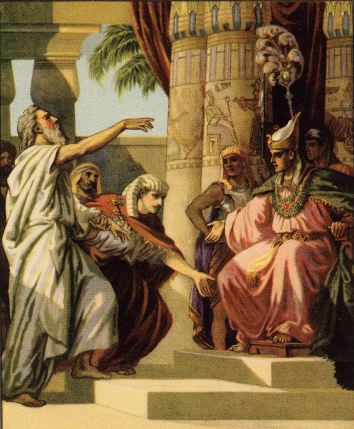 |
Jacob, age 130, meets Pharaoh.
Long after his children were born, and Joseph was prime minister of Egypt, Jacob took his family
there to survive a famine. When he appeared before Pharaoh, he stated that he was 130 years old
(Gen. 47:9), which was probably in the summer of 1762 BC. How old was his son Joseph at that
time? Joseph had become prime minister of Egypt at age 30 (Gen. 41:46). The seven years of
plenty began in the following year, and in the second year of the famine, Jacob's family
came to Egypt (Jasher 55:26). Thus, the time that Joseph became prime minister would have been
nine years earlier in 1771 BC. [9] He was age 30 at that time, so he would have been born in
1801 BC. Joseph was born at the very end of the seven years during which Jacob's first twelve
children were born, so that puts the seven years from 1808 to 1801 BC.
The proposed date for the marriage of Jacob to Leah is Sat 30 Mar 1808 BC, which was the day 14
Spring 14 SPRING on the Enoch calendar. That means it was Passover day (14 Spr) in the year
also representing Passover (14 SPR). That day only occurs once in 364 years, so that was a
rare day indeed, but it was nothing special on the Hebrew calendar. The next week he married
Rachel on Sat 6 Apr 1808 BC, which is the last day of passover on the Enoch calendar (21 Spr)
and also the minor holy day 1 Iyar on the Hebrew calendar.
This example shows how the days are
equally important, and neither wife is favored over the other because one date is more special on the
Enoch calendar and the other on the Hebrew calendar. The same will be true of the twelve sons of Jacob. In other words, the birthright went to Joseph not because his "stars" were better, but because of both his actions and Reuben's actions. The proposed twelve birth dates are all very nearly equally good, which is another factor which defies chance.
If these marriage dates are correct, then the birth of Jacob's first twelve children occurred during a seven year period
which corresponded to the Passover week of seven years on the Enoch calendar. The last born,
Joseph, has a proposed birth date in the year 21 SPRING on the Enoch calendar, corresponding to
the Last Day of Passover. In the Hebrew reckoning of years, it is similar. The marriage is in the
year 10 NISAN, which is a the year of Consecration, and the seven years includes the year of
PASSOVER. And both the first and last years are SATURDAY, the sabbath year of rest. If so, then it was a very unusual seven-year period during which these children were born from 1808 to 1801 BC.
1.3 Twelve Birthdays
Many years have been spent by this author in trying to determine the twelve actual birth dates for
the twelve sons of Jacob. There are many problems but the principal one is to discover whether or
not there is a pattern of holy days on sacred calendars which they all follow. Either God is using
the sacred calendars to determine the birth dates of his prophets and key leaders, or he is not.
Either they all follow a pattern or not. If they do, then there is a chance to discover the actual birth
dates of these twelve sons of Jacob. If they do not, then the best we could hope for might be to
determine the constellation associated with each birth, which would require an accuracy of about a
month.
In the former published articles from my research, there have been three general patterns proposed
that the birth dates of major prophets have followed. First, all births have occurred on holy days on the Hebrew Calendar, and usually also on holy days on other sacred calendars, with the Sacred
Round being the second most important. Second, the length of their lives has usually completed
an exact number of cycles on at least one sacred calendar. In the case of the antediluvian patriarchs
who lived hundreds of years, sometimes the lives completed two or more such cycles.[10] And
third, there has usually been a link from one parent to at least one child. That is, the interval
between the birth of one child and the death of one parent is often an exact number of cycles on one
calendar. In this case, there is one such link no matter what dates are proposed, because Benjamin
was born on the day his mother died. That is exactly zero cycles on all of the sacred calendars, and
it is perhaps the strongest parent-child calendrical link possible.
Rather than drag the reader through all my years of research on this subject, and preliminary
attempts to discover any pattern that could be proposed for the twelve birth dates, I will simply
report the results. It turns out that the requirement to fit eleven birth dates into eleven different
constellations (four of which are known) in only seven years, with the twelfth birth many years
later into the remaining zodiac figure is so difficult that one can easily rule out many potential
patterns.
Here is the pattern which emerged. Exactly as in the case of the patriarchs, each was born on a
holy day on the Hebrew calendar, and each was also born on either a day "1" or "7" on the Sacred
Round. This latter proposal concerning day 7 being a minor holy day is new in this article. I have
wondered about it for years. There are thirteen days in the time unit called the trecena on the
Sacred Round, and it has been clear that both the first and last days ("1" and "13") are sacred, but
there has not been an instance where the midpoint (or "meridian") day 7 of the trecena is also
known to be holy. Now that has changed. The birth requirements are so strict for these twelve that to me it now appears that the day 7 must be a minor holy day. All twelve of the birth days turn out to be equally important. The ones which occur on minor holy days instead of major are compensated by also
occurring on other sacred calendars, or having impressive conjunctions of the planets occur in the
sky on those dates. We have already seen this in the case of Abraham, whose birth date was not as
impressive on the calendar, but which was accompanied by a double conjunction of planets.[11]
Before listing the twelve birth dates, let us first turn to the difficult problem of determining at least
the year of Benjamin's birth.
1.4 Benjamin
What about the twelfth son, Benjamin? He was born many years later, and we are not even given
the year. Do we have any way of determining Benjamin's birth date? The answer appears to be in
the affirmative because of the many clues we are given about the time of his birth.
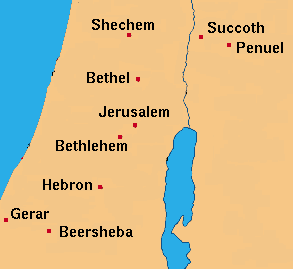 |
On his way to Hebron, Jacob stayed at Succoth, Shechem, and Bethel.
Let us review the history in just enough detail to deduce the year of Benjamin's birth. Laban
convinced Jacob to work for him six more years after the birth of Joseph (in the spring of 1801 BC).
At the end of those six years (in 1795 BC) Jacob took his family and left on his way to Canaan.
During that year he crossed the Jabbok at Peniel where he wrestled the angel who said his name
would be changed from Jacob to Israel. Then they sojourned a while in Succoth, and then moved to Shechem. There his daughter Dinah was defiled by Shechem (the prince and namesake of the town), leading to Simeon and Levi destroying the entire village. This caused Jacob to fear retribution from the local inhabitants, and when Jacob
prayed for help, the Lord told him to go south to Bethel, where he should stay and offer sacrifice
(Gen. 35:1). This he did, and there the Lord appeared to him and officially changed his
name to Israel, and told him that whole groups of nations would descend from him (Gen. 35:11).
While there, his mother Rebekah's nurse Deborah died and they also got word that his mother had also died in Hebron at the age of 133. After mourning for both, Rachel conceived, and later they decided to
relocate back to Hebron, further south. During that journey, when they came near Bethlehem, his
beloved Rachel died while giving birth to their twelfth son Benjamin (Gen. 35:16-18). They
continue on south to Hebron, where his father Isaac lived (Gen. 35:27).
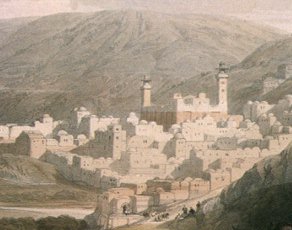 |
Hebron, home of Isaac and Rebekah.
So when was Benjamin born? The unknowns have been how long the family was at Succoth and
then how long they remained at Bethel. Of many possible approaches to solve this problem, the
following now seems the most straightforward. If we start from the premise that Rebekah died at
age 133, a year or so before the birth of Benjamin, then everything works out easily, because
Rebekah's birth date was already established in an earlier article.[12] This method avoids the
problems of exactly how long the family stayed in those two areas because it skips most of that
time period. It also dovetails nicely with the record of events after they arrived in Hebron.
1.5 Proposed Birth Dates
Here is a table of the proposed birth dates for the twelve sons of Jacob, as well as some other
related events, such as the births of Leah and Rachel. If the day on the sacred calendar is not a
holy day, then it is indicated at a dash (—). In the event column, "b." means birth, "c." means
circumcised (one week later), and "md." means married. On the Sacred Round calendar, the day
"1" represents beginning, so it is ideal for birth. In the cases where the birth is on "7", then the
circumcision day falls on "1" on an especially significant day. In the case of Reuben, it is 1 Water,
and Water is his emblem. In the case of Judah, the circumcision is on 1 Temple, where Temple
also signifies birth.[13]
| Event | Gregorian Date
(BC) | Hebrew | Sacred
Round | Other |
|---|
| Isaac b. | 16 Mar 1952 | Tue 10 Nisan | 1 Serpent | 1 Res (V) 1 Bir (M) |
| Rebekah b. | 8 Nov 1923 pm* | Wed 1 Kislev | 1 Jaguar | 1 Bir (V) 1 Res (M) |
| Jacob b. | 20 Mar 1892 pm* | Thu 15 Nisan | 1 Temple | 1 Birth (Venus) |
| Leah/Rachel b. | 2 Mar 1836 | Sat 15 Adar | 1 Storm | 1 Birth (Venus)
1 Lord (Merc) |
| Jacob begins work | 9 Apr 1815 | Sun 16 Nisan | 13 Deer | 15 Spr (Enoch) |
| Jacob/Leah md. | 30 Mar 1808 | Sat — | — | 10 NISAN (H)
14 Spr 14 SPR (Enoch) |
| Jacob/Rachel md. | 6 Apr 1808 | Sat 1 Iyar | — | 10 NISAN (H)
21 Spr (Enoch) |
| Reuben b. (Aqr) | 23 Dec 1808 | Mon 25 Kislev | 7 Wind | 10 NISAN (H)
14 SPR (E) |
| Reuben c. | 30 Dec 1808 | Mon 2 Tebeth | 1 Water | 1 Res (Merc) |
| Simeon b. (Cap) | 16 Dec 1807 pm* | Wed 1 Tebeth | 1 Flower | 1 Res (Merc) |
| Levi b. (Psc) | 5 Feb 1805 | Fri 1 Adar | 1 Condor | 1 Birth (Merc) |
| Dan b. (Sco) | 9 Oct 1805 pm* | Mon 15 Tishri | 1 Temple | 1 Adult (M) |
| Judah b. (Leo) | 19 Jun 1804 pm* | Tue 1 Tammuz | 7 Condor | 14 NISAN |
| Naphtali b. (Vir) | 17 Aug 1804 pm* | Fri 1 Elul | 1 Eagle | 14 NISAN, 1 Prime (V) |
| Gad b. (Sgr) | 2 Nov 1803 pm* | Sat 1 Kislev | 1 Quake | 15 NISAN, 1 Cre (M) |
| Issachar b. (Cnc) | 29 May 1802 | Wed 1 Sivan | 1 Serpent | 1 Res (M) |
| Asher b. (Lib) | 23 Sep 1802 pm* | Tue 1 Tishri | 1 Wind | 1 Res (M) |
| Zebulon b. (Ari) | 4 Mar 1801 | Tue 14 Adar | 7 Dragon | |
| Joseph b. (Tau) | 6 Apr 1801 | Sun 18 Nisan | 1 Quake | 15 Spr 21 SPR (E) |
| Rebekah d. | 6 Apr 1790 pm* | Sun 18 Nisan | 1 Jaguar | 15 Spr (E), 1 Lord (V) |
Benjamin b. (Gem)
Rachel d. | 25 May 1788 | Tue 1 Sivan | 1 Jaguar | 1 Adult (V), 1 Lord (M) |
| Leah d. | 1 Jul 1786 pm* | Sun 1 Tammuz | 1 Light | 1 Res (V), 1 Adt (M) |
Ephraim &
Manasseh b. (Tau) | 3 Apr 1767 | Thu 1 Nisan | 1 Grass | 1 Prime (M) |
| Jacob d. | 14 Apr 1745 pm* | Tue 15 Nisan | 1 Storm | 1 Birth (V) 1 Cre (M) |
| Joseph d. | 5 Mar 1691 pm* | Sun 1 Nisan | 1 Light | 9 AB (H), 9 MSU(E) |
Let us consider some of these results and their implications in more detail.
2. New Holy Days
One problem that has been difficult in all of this research is to know just what the "official" holy
days are on the Hebrew Calendar. What are the holy dates which the Lord has on his calendar, not
including those which have just been added by man to celebrate joyous occasions? It must be
remembered that all of these births occurred long before the birth of Moses, and most of them
would celebrate future events. Many of the holy days are explicitly
described in the law of Moses, so there is little question about them. But what about Hanukkah,
the eight-day Festival of Lights which commemorates the rededication of the temple in 165 BC?
Was that date on God's calendar from the beginning? What about the Feast of Esther which
celebrates Esther's saving the Israelites from execution in the fifth century BC? These questions
have puzzled me for years.
2.1 Hanukkah
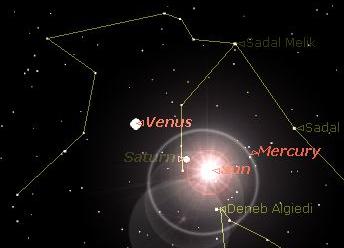 |
Grouping of Mercury, Venus, Saturn and the Sun in the Water Bearer on Hanukkah, 1808 BC.
The dates for Reuben teach us several things. First, to me it appears to establish the first (and
last?) day of Hanukkah to be an official minor holy day. The first day of Hanukkah
falls on 25 Kislev, near the Christian Christmas season. The last day occurs seven days later on
either 2 Tebeth or 3 Tebeth, depending on whether the month of Kislev has 29 or 30 days.
Reuben's birth date was almost certainly on Hanukkah, and the day of his circumcision one week
later would have fallen on the last day. That day was "1 Water" on the Sacred Round, and Water
is the symbol of the Water Bearer constellation (Reuben). As shown in the illustration, there was also a
grouping of three planets with the sun in the Water Bearer on Hanukkah (25 Kislev) that year.
2.2 Feast of Esther
The same question concerns the Feast of Esther on 14-15 Adar. Are those two days "official" holy
days or not? Again, the answer seems to be in the affirmative, because the twins Zebulon and
Dinah were most likely born on 14 Adar. Not only does the date fit the pattern perfectly, the
planets Mercury and Venus were both located in the leg of the Ram which is breaking the bands
of death. Henceforth in these articles, both Hanukkah and the Feast of Esther will be treated as
minor holy days.
2.3 Easter
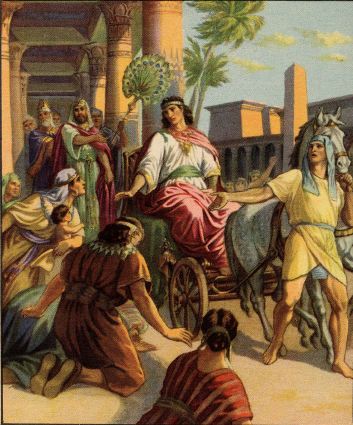 |
Joseph was probably born on Easter.
Again, a similar question arises concerning Easter, called the Waving of the Omer on the Hebrew
Calendar. It falls on the Sunday after Passover, but was not declared to be a holy day in the law
of Moses, but only the day of a special offering of the firstfruits from the ground. After the
Resurrection of Jesus Christ, it became clear that this was really a major holy day, but was it
an official holy day from the beginning? To me the answer now appears to be in the affirmative
because the birth of Joseph most likely occurred on Easter Sunday of 1801 BC.
An interesting point is that Genesis states that Joseph was born at the completion of the second seven years (Gen. 30:25). According to these proposed dates, it was exactly seven years on the Enoch calendar from his marriage to Leah, and also exactly 14 years from when he began work for Laban. Apparently the seven year periods were precise to the very day.
3. Confirming Dates
Now let us look at some of the birth and death dates of the parents and grandparents of these
twelve sons. They form the same type of interlocking pattern as we have seen in earlier articles
about the birth dates of the antediluvian patriarchs.
3.1 Rebekah
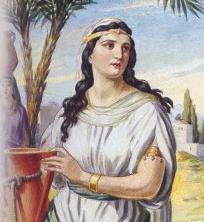 |
Rebekah, born and died on 1 Jaguar.
One result of this study is the proposed death date for Jacob's mother Rebekah. Her death date is
the key link in discovering the birth date of Benjamin. Her death date now appears solid enough to
be the basis of forming an anchor point in history.
As discussed in an earlier article, the proposed birth date for Rebekah ties perfectly to her husband
Isaac's. Her proposed birth date is Tue 8 Nov 1923 BC pm* which was 1 Kislev (Hebrew), 1
Jaguar (Sacred Round), 1 Birth (Venus) and 1 Resurrection (Mercury). His proposed birth date is
Tue 16 Mar 1952 BC, being 10 Nisan (Hebrew), 1 Serpent (S. R.), 1 Resurrection (Venus) and 1
Birth (Mercury). The important feature to note is that the Venus and Mercury calendar dates are
reversed for the two, just as they are for Ishmael and Isaac. That was such a rare coincidence as to
really lock in her birth date.
The Book of Jasher, states that Rebekah died at age 133 while the family was at Bethel, shortly
before the conception of Benjamin (Jasher 36:6). An ideal date is found at that time, being Sat 6
Apr 1790 BC, which was the same day as her birth on the Sacred Round (1 Jaguar). It is common
in the ages of the patriarchs (and now matriarchs) to have their life be an exact number of cycles on
one of the sacred calendars. In this case, the length of Rebekah's life would be exactly 186 Sacred
Rounds. The day was also Easter on both the Hebrew and Enoch calendars, as was Joseph's
proposed birth date. Again, it is common to have the period to the birth of a child or grandchild be
an exact number of cycles. Moreover, it was also a holy day on the Venus calendar, as was her
birth, and there are only 16 days in 584 days that such an alignment occurs. So these fulfillments
of multiple patterns convince me that he death date truly has been found: Sat 6 Apr 1790 BC pm*.
3.2 Leah and Rachel
After discovering how impressive Rebekah's death date and life was, it caused me to search for the
birth and death dates of both Leah and Rachel. Their birth and death years, and ages, are given in
the Book of Jasher (Jasher 36:11,
41:2), so it was a much easier problem than the birth
of the twelve sons of Jacob. Jasher also mentions that they were twins (Jasher
28:28), even as were Jacob and Esau.
Their birth date was most likely Sat 2 Mar 1836 BC, which was the Feast of Esther (Hebrew), 1
Birth (Venus) and 1 Lord (Mercury). Thus, it is proposed that both of these wives were born on 1
Birth (V) as was Jacob, so that is a rare match. Rachel's death occurred at Benjamin's birth, and
the day was also 1 Lord (M), so her life completed an exact number of cycles on the Mercury
calendar. It was also on 1 Jaguar, the same as Rebekah's proposed birth and death dates.
Leah only lived a few years longer than Rachel, dying before Joseph was sold into Egypt. Her
death was most likely on Sat 1 Jul 1786 BC pm*, which was 1 Tammuz, the same as her son
Judah. It was also 1 Res (V), the same as Isaac's birth date, and also 1 Adult (M) the same
as Jacob's birth date. Again, these are not just holy days, but the match the pattern of being the
same as husband and children. It was also 1 Light (S.R.), the day beginning that cycle. These are
enough patterns to merit publishing this date as likely to be her death date.
3.3 Jacob
 |
Jacob lived an exact number of Hebrew years and Venus cycles.
One new date which emerged from this study is Jacob's death date. After discovering that
Rebekah's life most likely was an exact number of Sacred Rounds as well as being a holy day on
the Venus calendar, it seemed like a good idea to search for Jacob's death date. To me the result
was stunning. By far the most likely date is Mon 14 Apr 1745 BC pm* which was both Passover
and also 1 Birth on the Venus Calendar. It is amazing that such a date exists exactly 147 Hebrew
years after his proposed birth date on Wed 20 Mar 1892 BC pm* which was also Passover and
also 1 Birth (Venus). Until writing this article, I had not even considered that possibility for at
least two reasons. First, 147 = 3 x 49, meaning that his life was exactly three jubilees long, and
that alone was impressive enough to me to stop looking. Secondly, 1 Birth (Venus) only occurs
on Passover about twice in 584 years on the average, so one wouldn't expect it after only 147
years. Note also that both 1 Birth (V) and 1 Temple, on which he was born, are the very days of those cycles that represent birth. Thus, this is yet another compelling confirmation of the birth date proposed for Jacob several years ago. [14]
3.4 Joseph, Ephraim and Manasseh
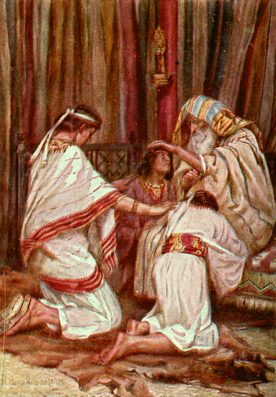 |
Jacob blesses Ephraim & Manasseh.
The book of Jasher states that Joseph's two sons were born when he was age 34 (Jasher
50:15).
While not stating that they are twins, my conclusion is that they are, because they are compared to
the horns of the wild ox (Deut. 33:17), and there is a clear birth date for them when the sun is in
the constellation of the Bull, the constellation of Joseph, whom they would replace in the set of
twelve tribes. Moreover, there is a clear candidate to be the death date for Joseph at age 110 (Gen.
50:26) and it occurs on the same day of the Hebrew years as the proposed birthday for his sons (1
Nisan). Moreover, their birthday fills in one more very important holy day to the set of twelve
(New Year's Day). Thus, the timing of the births appears to have been foreseen and carefully
planned.
4. Scriptural Confirmation
There are several clues in the scriptures about which constellation is associated with which tribe,
but some are not obvious at all. When I began this study I was really encouraged about how easy
the four cornerstone constellations were, because each of those four tribes (Reuben, Dan, Judah,
and Joseph) were compared to the figures (Water Bearer, Scorpion, Lion, Bull) explicitly in their
names or blessings. Moreover, Dan means "Judge" and Judah means "Praised," both of which tie
directly to the corresponding roles of Jesus Christ of Judge and King, as discussed in last month's
article. So those are the four about which everyone agrees. But the other eight were not obvious and
there is little agreement about them.
After I had finished this study and had determined the birth dates in the above table, and was in the
process of writing this article, the idea occurred to me to read those names and blessings one more
time. It was surprising how easy it was to see that there were strong indications in front of me all
the time, but many of them are only clear in the light of knowing how the twelve roles of Jesus
Christ correspond to the twelve constellations.
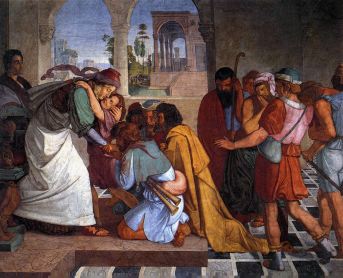 |
Joseph reveals himself to his brothers.
Simeon is the Sacrifice. There are two clues that Simeon is the Sea-Goat which is sacrificed.
First, the blessing by Jacob stated, "Simeon and Levi are brethren; instruments of cruelty are in
their habitations" (Gen. 49:5). What does that mean? Ostensibly, it refers to their slaying of the
village of Shechem to defend their sister Dinah's honor, but could there be more? It occurred to
me that Levi's sign is Pisces, which contains the chains or bonds which shackle the fish to the Sea
Monster. Those are certainly instruments of cruelty. And the Sea-Goat is the other sign which
refers to an animal about to be slaughtered by the knife. Thus, the Sea-Goat is a good match for
Simeon's instrument of cruelty. Moreover, it was Simeon whom Joseph kept behind in Egypt as a
ransom for Benjamin, that is, he was the sacrifice.
Levi is The Fishes. Levi means "Joined" which now seems like a clear reference to the Fishes,
which are joined by two bands or chains to the Sea Monster. Moreover, Levi's tribe was that to
whom the priesthood was given, which corresponds to the Fishes representing the role of Jesus
Christ as the Great High Priest.
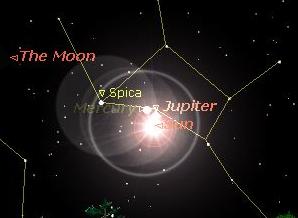 |
Conjunction of Mercury, Jupiter and the Sun in the Maiden at birth of Naphtali.
Naphtali is the Maiden. There are at least three scriptural clues that Naphtali corresponds to
the constellation of the Maiden. First, in the blessing of Jacob, he is compared to a hind or doe,
that is, a female deer. Why not a buck? Perhaps it is because he ties to the female constellation.
Secondly, in his blessing by Moses, he is told he will be "full with the blessing of the Lord." As
in many languages today, the word "full" has the double meaning of expecting a baby. Truly the
Virgin Mary was "full with the blessing of the Lord." Thus both blessings contain references not
only to females, but one to an expectant mother, which is clearly the Virgin's Seed. Finally, the
name Naphtali means "to struggle or wrestle," [15] which could describe the struggle of giving
birth.
Gad is the Archer. The name Gad means "fortune," coming from the root which means an
invading troop or an attack which overcomes. The Archer is like a one man cavalry (a centaur)
attacking and overcoming the scorpion with bow and arrow.[16] His blessing was that Gad "shall
overcome at last" (Gen. 49:19) which again fits perfectly with the Archer representing Christ as the
"Savior."
Issachar is the Crab. The name Issachar means to "he will bring a reward"[17]. That is
exactly the role of the Crab, who represents Christ as the "Deliverer" who brings the captive dead
forth from Hades. And his blessing echoes this theme: he is likened to a donkey "crouching down
between two burdens" and "becoming a servant unto tribute" (Gen. 49:14-15).
Thus, six of the eight tribes with unknown constellations have hints in their names or roles of
Christ. The other two Asher ("happy") and Zebulon ("habitation")[18] are not as obvious.
Asher may well tie to the Balance because of the joy that comes after the price has been paid. And
Zebulon's "dwelling" could refer to the everlasting life of the Ram's golden fleece, but neither of
these is nearly as straightforward as the other six.
5. Conclusion
The mystery of how the twelve constellations of the zodiac correspond to the twelve tribes of Israel
appears now to have been solved by applying knowledge of the Lord's sacred calendars to the
chronological clues in the scriptures and the Book of Jasher. Confirmation is found in the meanings
of their names, as well as in the corresponding roles of Jesus Christ. Some of the implications are
that Hanukkah, the Feast of Esther, and Easter are all Hebrew holy days which were on the Lord's
calendar from as early as the time of Jacob. All of these together testify of the importance of the
Lord's calendars as a tool to determine the exact dates of key historical religious events, and to
provide many more witnesses of the historicity and accuracy of the scriptures.
Notes
- See Pratt, John P., "Enoch Calendar Testifies of Christ," Meridian Magazine (11 Sep 2001) for authenticity of Book of Enoch, and " The Constellations Testify of Christ," Meridian Magazine (9 Oct 2001), section 1.8, for reference to Uriel revealing the constellations.
- Pratt, John P., " The Constellations Tell of Christ," Meridian Magazine (15 Jun 2005), called "The Zodiac Testifies of Christ" on my website.
- Pratt, John P. "The Lion and Unicorn Testify of Christ, Part I: The Cornerstone Constellations," Meridian Magazine (8 Nov 2001).
- Pratt, John P., "Venus Resurrects This Easter Sunday," Meridian Magazine (27 Feb 2001) for Venus and Mercury calendars, and footnote 1 above for Enoch Calendar. The Perpetual Hebrew Calendar has yet to be published, being a work in progress.
- Pratt, John P., "A Native American Easter: How the Ancient American Calendar Testifies of Christ," Meridian Magazine (28 Mar 2001) is an introduction to the Sacred Round.
- Pratt, John P., "How Did the Book of Jasher Know?," Meridian Magazine (7 Jan 2002).
- The Book of Jubilees states, "and she bore twins, a boy and a girl, and she called the boy Zebulun and the girl's name was Dinah" (Jubilees 28:23), from Charlesworth, James H., The Old Testament Pseudepigrapha (Garden City, N.Y.: Doubleday, 1985), vol 2, p. 110. I believe that account correct, but in general Jubilees is entirely unreliable in chronology and has all the earmarks of having been largely a fabrication. It gives many precise dates to give the feeling of authenticity, but they all appear to be nonsense. In this case, the birth dates of the twelve sons do not all fall within seven years, but within fourteen, which is not what is described in Genesis.
- Pratt, John P., "Divine Calendars Testify of Abraham, Isaac, and Jacob," Meridian Magazine (11 Sep 2003), section 6.
- Thus, Joseph would have been 39 years old when his father was 130, meaning that Jacob was 91 years old when Joseph was born. That age is confirmed in the Book of Jasher (Jasher
31:21).
- One notable example is Jared, the father of Enoch, who lived 602 Venus cycles and also 1,352 Sacred Rounds. See Pratt, John P., "Astronomical Witnesses of the Great Flood," Meridian Magazine (13 Aug 2003), section 2.5.
- Pratt, John P., "Divine Calendars Testify of Abraham, Isaac, and Jacob," Meridian Magazine (11 Sep 2003), section 2.5.
- Pratt, John P., "Divine Calendars Testify of Abraham, Isaac, and Jacob," Meridian Magazine (11 Sep 2003), section 5.
- The meanings of the twenty day names are discussed by Pratt, John P., "The Twenty Day Names," (20 Apr 2000).
- See footnote 8.
- Strong, James, The Exhaustive Concordance of the Bible (McClean Virgina: MacDonald) Hebrew words 5321, and 6617.
- Strong, Hebrew words 1410, 1464.
- Strong, Hebrew word 3485.
- Strong, Hebrew word 836 (Asher) and 2074 (Zebulon).













